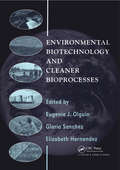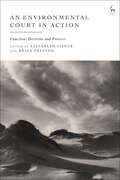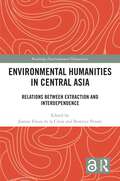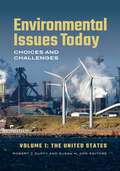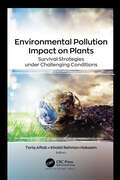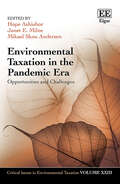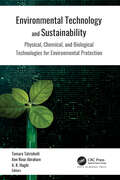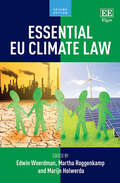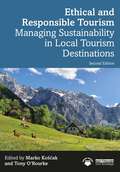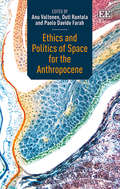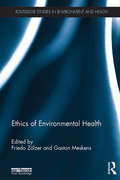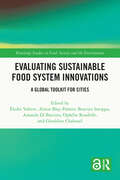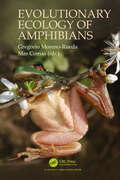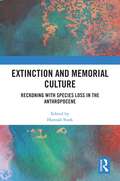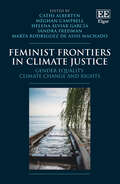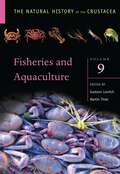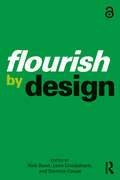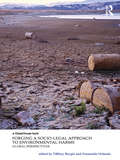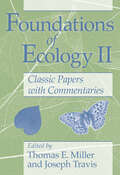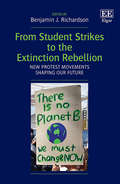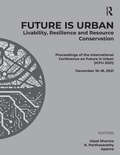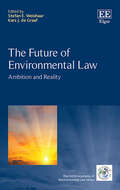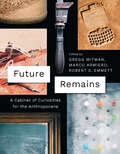- Table View
- List View
Environmental Biotechnology and Cleaner Bioprocesses
As we enter a new millennium, the environmental issues faced by both developing and industrialised nations are as pressing as ever. Environmental biotechnologies are increasingly being viewed as a major weapon against environmental damage. Cleaner production is part of this strategy and yet there is still widespread ignorance about this emerging technology. Environmental Biotechnology and Cleaner Bioprocesses provides this information at various levels, from introductory to advanced. The first section covers the development of cleaner bioprocesses within the framework of sustainable development. Aspects of environmental policy for small and medium businesses are then discussed using case studies to illustrate principles. The second section covers the recycling and treatment of organic waste, including the use of aquatic plants and microalgae for wastewater treatment and recovery of nutrients. Section three covers bioremediation technologies and finally, section four is dedicated to emerging cleaner bioprocesses and environmentally sound products. All chapters have been written and edited by leading authorities in the field. Students and professionals interested in environmental biotechnology and cleaner production will find the background information and detail they require in this one convenient source.
An Environmental Court in Action: Function, Doctrine and Process
This book provides a critical assessment of the New South Wales Land and Environmental Court (NSWLEC). Effective adjudication has become a key consideration for environmental lawyers. One of the most important questions is whether environmental law frameworks need their own courts, with the conclusion being: yes they do. Here, a pioneer of such a court, the NSWLEC is forensically examined to see what it might teach other such courts. Showing a court 'in action' it suggests models that practitioners and policy makers might follow. It also speaks to the environmental law scholars, setting out a conceptual framework for studying such courts as legal institutions. This multi-faceted collection is invaluable to scholars and practitioners alike.
Environmental Humanities in Central Asia: Relations Between Extraction and Interdependence (Routledge Environmental Humanities)
This book is the first collection to showcase the flourishing field of environmental humanities in Central Asia. A region larger than Europe, Central Asia possesses an astounding range of environments, from deserts to glaciated peaks. The volume brings into conversation scholarship from history to social anthropology, demonstrating the contribution that interdisciplinary and engaged research offers to many urgent issues in the region: from the history of conservationism to the tactics of environmental movements, from literary engagements with ‘pure nature’ to the impact of fossil fuel extraction. The collection focuses on the Central Asian republics of the former USSR, where a complex layering of nomadic and sedentary, Turkic and Persianate, Islamic and Soviet cultures ends up affecting human relations with distinct environments. Featuring state-of-the-art contributions, the book enquires into human-environment relations through a broad-brush typology of interactive modes: to extract, protect, enspirit and fear. Broadening the scope of analysis beyond a consideration of power, the authors bring into focus alternative local cosmologies and the unintended consequences of environmental policy. The volume highlights scholarship from within Central Asia as well as expertise elsewhere, offering readers diverse modes of knowledge-production in the environmental humanities. This book is an important resource for researchers and students of the environmental humanities, sustainability, history, politics, anthropology and geography of Asia, as well as Soviet and Post-Soviet studies.
Environmental Issues Today [2 volumes]: Choices and Challenges [2 volumes]
This two-volume set provides an authoritative overview of the major environmental issues of the 21st century, with a special focus on current challenges, trends, and policy choices.This set provides an up-to-date, comprehensive, and focused resource for understanding the nature and scope of environmental challenges facing the United States and the world in the 21st century, as well as options for meeting those challenges. Volume One covers environmental trends and challenges within the United States, while Volume Two illuminates environmental issues and choices around the world. Issues covered in both volumes include vital topics such as climate change, air and water pollution, natural resource and species protection, and agricultural/industrial impacts on the environment and public health. For all topics, the authors—scholars and experts hailing from a wide range of environmental and policy fields—detail a range of political, social, and economic options for the future and explain why the issue in question is important for society and people as well as the natural world.
Environmental Pollution Impact on Plants: Survival Strategies under Challenging Conditions
This new volume studies the impact and management of environmental pollution on plants, often resulting in plant abiotic stress physiology, which causes reduction in growth due to alterations in biochemical and physiological processes, thus threatening food security, the ecosystem, and the plants themselves. This volume details the harm to plants caused primarily by heavy metal contamination in soils, by pesticides use, and by air pollution and presents several mitigation strategies as well. Soils contaminated with heavy metals is a major challenge worldwide due to increase in anthropogenic and geologic activities. Despite the effectiveness of pesticides in preventing pest invasions and yield decline, pesticides and other air pollutants cause biochemical changes that can instigate leaf damage, stomatal impairment, early senescence, decrease in photosynthetic efficiency, interruption of membrane perviousness, and decrease of growth and yield in sensitive plant types. Chapters in this volume address these issues. Topics include the antioxidant, photosynthesis, and growth characteristics of plants grown in polluted soils; the benefits and hazards of pesticides; microbe-assisted bioremediation and biotechnological advances for plant pollution control; genetically modified plants and their potential resistance to environmental pollution; and more.
Environmental Taxation in the Pandemic Era: Opportunities and Challenges (Critical Issues in Environmental Taxation series)
At a time when climate change and the Covid-19 pandemic pose a global existential threat, this timely and important book explores how policy responses to a pandemic create both opportunities and challenges for the increased use of environmental pricing instruments, such as carbon taxes, and tradable permit schemes, and targeted green fiscal incentives.The chapters provide an important foundation of knowledge and analysis about how a pandemic affects environmental tax policy. They identify lessons from policy makers’ responses to the management of the pandemic and implications for addressing the threat of climate change and other environmental challenges. They highlight the need for environmental pricing instruments in the mix of policy instruments even in the wake of a pandemic. They present theory and empirical analysis, and they feature a number of country-specific case studies, including the experience of developing countries.This book takes readers into the important and unprecedented circumstances of our time where pandemic policy meets environmental policy for the short and long terms. It will be of great interest to researchers, students and scholars in environmental policy, tax and law, as well as the industry sector, policy makers and government officials.
Environmental Technology and Sustainability: Physical, Chemical and Biological Technologies for Environmental Protection
This new title covers the most recent theoretical and practical advancements in green technology for a clean and healthy environment. It aims to provide a better understanding of the research and development of new technologies that are becoming increasingly important for ensuring sustainability.The book provides vital information on advanced materials and green composites and expounds on environmental chemistry for a sustainable world, focusing on different characterization methods as well as new techniques. The volume also considers recent developments and applications of clean energy materials. It presents case studies that emphasize the green technologies being discussed.
Essential EU Climate Law
This thoroughly revised second edition provides an up-to-date account of essential EU climate mitigation law, analysing an area that remains one of the most dynamic fields of EU law. Special attention is paid to the energy sector and to the impact of climate law on broader legal issues, such as energy network regulation and human rights.Written by leading scholars of EU climate law from the University of Groningen, the book addresses the relevant directives and regulations, examining their implementation and impact on current policy and academic debate. Chapters guide the reader through key topics including the EU emissions trading system, renewable energy consumption, and carbon capture and storage.Key features of the second edition include:A clear and accessible introduction to EU climate mitigation lawComprehensive coverage of the climate targets and instruments of the EUSpecial focus on the relationship between climate law and energy lawNew classroom questions to stimulate further discussion and debateEducational design based on reviews by climate law students and lecturers.Combining educational design and analytical accuracy, this book will be an indispensable guide for both students and professionals. It is highly recommended for courses on EU climate mitigation law, as well as climate law, energy law, environmental law and EU law.
Ethical and Responsible Tourism: Managing Sustainability in Local Tourism Destinations
Ethical and Responsible Tourism explains the methods and practices used to manage the environmental impact of tourism on local communities and destinations. This new edition takes into account recent global events such as the Covid-19 health crisis, the impacts of the war in Ukraine on tourism in neighbouring regions and the consequences of the energy and cost of living crisis. The three core themes of the book – destination management, environmental and social aspects of ethical sustainable development and business impacts – are discussed across both topic and case study chapters, alongside explanatory editorial analysis with all chapters clearly signposted and interlinked. The case studies address specific and practical examples from a global range of examples including sites in Australasia, Central America, Europe, Asia, North America and South America. In this new edition, further case studies are included from the USA and Japan, as well as new examples from Brazil, Croatia and Malta. Used as a core textbook, the linking of theory in the topic chapters, and practice gained through case studies, alongside further reading and editorial commentary, Ethical and Responsible Tourism provides a detailed and comprehensive learning experience. Specific case studies can be used as standalone examples as part of a case teaching approach, and the editorial and discussion elements are designed to be suitable for those simply seeking a concise overview, such as tourism professionals or potential investors in sustainable tourism projects. This revised edition continues to be essential reading for students, researchers and practitioners of tourism, environmental and sustainability studies.
Ethics and Politics of Space for the Anthropocene
Featuring an international, multidisciplinary set of contributors, this thought-provoking book reimagines established narratives of the Anthropocene to allow differences in regions and contexts to be taken seriously, emphasising the importance of localised and situated knowledge. Envisaging a narrative of change that renders visible the complex transformations taking place across the globe, this book outlines new and radical ways to address the current environmental crisis in a more sustainable and context-specific manner. It presents empirical studies from various contexts, highlighting the potentiality of non-Western knowledge, concepts and categories as well as recognising the entanglement of humans with other beings and ecosystems. In particular, it offers critical engagement with the debates around the Anthropocene by challenging the dominant techno-rational agenda that often prevails in socio-political and academic discussions. This book will be crucial reading for researchers and postgraduate students working in fields from human geography and tourism studies to law, public policy and administration, philosophy, politics and organisation studies who are dealing with intersecting issues of environment, sustainability, indigenous rights, space and ethics. It will also be helpful for policymakers and research consultants in leveraging localised solutions to the current ecological crisis.
The Ethics of Animal Shelters
Ethical dilemmas and decision-making are a persistent feature of the everyday operations of animal shelters and animal protection organizations. These organizations frequently face difficult decisions about how to treat the animals in their care, decisions that are made all the more difficult by limited funding, material resources, and human labor. Moreover, animal protection organizations must also determine how to act within and toward the wider social and institutional environment in which non-human animals are routinely exploited. The first section of The Ethics of Animal Shelters contains practical recommendations developed by ethicists in response to the ethical challenges identified by employees of the Montreal Society for the Prevention of Cruelty to Animals. These challenges arise across the organization's activities, including its internal structure; shelter operations; public campaigns and advocacy work; dealing with the public, animal agriculture and governmental agencies; and their work with feral animals. The second section offers philosophical analyses of the ethical challenges unique to animal shelters. Issues explored include the killing of shelter animals; shelter animals' diets; medical decision-making procedures; adoption policies; and the role shelters might play in transforming social attitudes and norms.
Ethics of Environmental Health (Routledge Studies in Environment and Health)
Environmental health encompasses the assessment and control of those environmental factors that can potentially affect human health, such as radiation, toxic chemicals and other hazardous agents. It is often assumed that the assessment part is just a matter of scientific research, and the control part a matter of implementing standards which unambiguously follow from that research. But it is less commonly understood that environmental health also requires addressing questions of an ethical nature. How can we determine the "acceptable" risk level for the general population or for certain groups? How should we deal with uneven distributions of risks and benefits? How do we communicate about risks with the stakeholders? This multidisciplinary collection brings together a number of leading researchers and scholars in order to generate discussion surrounding these key questions, and to bring the ethical implications of science and technology to the forefront of critical thought. Providing a broad overview of the Ethics of Environmental Health, its philosophical foundations and practical applications, this book offers a significant contribution to ongoing discussions in sustainable development and will be of interest to scholars and practitioners of Environmental Health, urban studies and healthcare.
Evaluating Sustainable Food System Innovations: A Global Toolkit for Cities (Routledge Studies in Food, Society and the Environment)
This book presents URBAL, an approach that applies impact pathway mapping to understand how food system innovations in cities, and their territories, change and impact food system sustainability. Around the world, people are finding innovative ways to make their food systems more sustainable. However, documenting and understanding how these innovations impact the sustainability of food system can be a challenge. The Urban Driven Innovations for Sustainable Food Systems (URBAL) methodology responds to these constraints by providing innovations with a simple, open-source, resource-efficient tool that is easily appropriated and adaptable to different contexts. URBAL is designed to respond to the demands of field stakeholders, whether public or private, to accompany and guide them in their actions and decision-making with regard to sustainability objectives. This book presents this qualitative and participatory impact assessment method of food innovations and applies it to several cases of food innovation around the world, including the impact of agricultural districts in Milan, chefs and gastronomy in Brasilia, e-commerce in Vietnam, eco-friendly farm systems in Berlin and The Nourish to Flourish governance process in Cape Town. The book demonstrates how food innovations can impact different dimensions of sustainability, positively and negatively, and identify the elements that facilitate or hinder these impacts. The volume reflects on how to strengthen the capacity of these stakeholders to disseminate their innovations on other scales to contribute to the transition towards more sustainable food systems. This book will be of great interest to students and scholars working on sustainable food systems, urban food, food innovation and impact assessment, as well as policymakers, practitioners and funders interested in these areas.
Evolutionary Ecology of Amphibians
Amphibians are the oldest tetrapod group and show an astonishing diversity in lifestyles, many of them being unique. However, globally, they are on a decline. Hence, their study is fundamental to understanding the evolution of diversity and conserving them. This book, authored by experts from around the world, summarizes the current knowledge on the evolutionary ecology of amphibians. The book treats biological concepts related to the evolution, ecology, physiology, immunology, behaviour, and morphology of amphibians in their different states. This book constitutes an actualized work indispensable for evolutionary ecologists and herpetologists.
Extinction and Memorial Culture: Reckoning with Species Loss in the Anthropocene
This book considers how we encounter and make meaning from extinction in diverse settings and cultures. It brings together an international and interdisciplinary range of scholars to consider how extinction is memorialised in museums and cultural institutions, through monuments, in literature and art, through public acts of ritual and protest, and in everyday practices. In an era in which species are becoming extinct at an unprecedented rate, we must find new ways to engage critically, creatively, and courageously with species loss. Extinction and Memorial Culture: Reckoning with Species Loss in the Anthropocene develops the conceptual tools to think in complex ways about extinctions and their aftermath, along with providing new insights into commemorating and mourning more-than-human lives. This book will be of great interest to students and scholars of the environmental humanities, extinction studies, memorial culture, and the Anthropocene.
Feminist Frontiers in Climate Justice: Gender Equality, Climate Change and Rights
Feminist Frontiers in Climate Justice provides a compelling demonstration of the deeply gendered and unequal effects of the climate emergency, alongside the urgent need for a feminist perspective to expose and address these structural political, social and economic inequalities. Taking a nuanced, multidisciplinary approach, this book explores new ways of thinking about how climate change interacts with gender inequalities and feminist concerns with rights and law, and how the human world is bound up with the non-human, natural world.With contributions from leading scholars in law, feminism, human rights and politics, this book considers how equality is conceptualised experienced and used in policies, law and practice that are integral to climate justice. Chapters reveal how international and national policy and legal frameworks fall short on gender equality and climate justice. Overall, the book demonstrates that the climate crisis demands an ambitious and transformative approach to equality, including developing feminist ideas of care and social reproduction, to reconstruct law and policy towards a more just world for all.This ground-breaking book will be essential reading for scholars across many areas of law including environmental law, human rights, public international law, law and gender, and law and development. Its discussion of the international framework alongside in-depth casestudies and assessments of women’s mobilization strategies will also be highly relevant to social scientists, officials in international organizations, policymakers, lawyers and activists.
Feminist Solutions for Ending War
‘War is a man’s game,’ or so goes the saying. Whether this is true or not, patriarchal capitalism is certainly one of the driving forces behind war in the modern era. So can we end war with feminism? This book argues that this is possible, and is in fact already happening. Each chapter provides a solution to war using innovative examples of how feminist and queer theory and practice inform pacifist treaties, movements and methods, from the international to the domestic spheres. The contributors propose a range of solutions that include arms abolition, centring Indigenous knowledge, economic restructuring, and transforming how we ‘count’ civilian deaths. Ending war requires challenging complex structures, but the solutions found in this edition have risen to this challenge. By thinking beyond the violence of the capitalist patriarchy, this book makes the powerful case that the possibility of life without war is real.
Fisheries and Aquaculture: Volume 9 (The Natural History of the Crustacea)
This is the ninth volume of ten in the The Natural History of the Crustacea Series. The chapters in this volume synthesize the diverse topics in fisheries and aquaculture. In the first part of the book, chapters explore worldwide crustacean fisheries. This section comes to a conclusion with two chapters on harvested crustaceans that are usually not within the focus of the mainstream fisheries research, possibly because they are caught by local fishing communities in small-scale operations and sold locally as subsistence activity. In the second part of the book, the authors explore the variety of cultured crustacean species, like shrimps, prawns, lobsters, and crabs. Chapters in the third part of the volume focus on important challenges and opportunities, including diseases and parasitism, the use of crustacean as bioindicators, and their role in biotechnology.
Flourish by Design
Flourish by Design brings together a range of established and emerging voices in design research for a collection that provides original provocations on topics of global significance. It is an insightful guide to original theory and practice concerning how we can design for a better tomorrow. Featuring contributors from a diverse array of backgrounds and professions, this edited book explores the difference that design and design research can make for people, organisations, and the planet to prosper now and in the future. It offers a range of ideas and techniques through practical examples and ongoing projects showing how applied design research can respond to global challenges. Covering topics as diverse as artificial intelligence, bio-inspired materials, more-than-human design, sustainability, and urban acupuncture, it shares interdisciplinary and transdisciplinary design research not just to demonstrate what could be plausible in the near future but also to explain why it might be preferable. By sharing these despatches, this collection represents the very best of what design research can do, explaining how and why. This book is intended for a wide audience of professionals, scholars, and students in design, architecture, and public policy, as well as anyone who has an interest in how we design the world and, in turn, it designs us.
Forging a Socio-Legal Approach to Environmental Harms: Global Perspectives (Law, Justice and Ecology)
Environmental harms exert a significant toll and pose substantial economic costs on societies around the world. Although such harms have been studied from both legal and social science perspectives, these disciplinary-specific approaches are not, on their own, fully able to address the complexity of these environmental challenges. Many legal approaches, for example, are limited by their inattention to the motivations behind environmental offences, whereas many social science approaches are hindered by an insufficient grounding in current legislative frameworks. This edited collection constitutes a pioneering attempt to overcome these limitations by uniting legal and social science perspectives. Together, the book’s contributors forge an innovative socio-legal approach to more effectively respond to, and to prevent, environmental harms around the world. Integrating theoretical and empirical work, the book presents carefully selected illustrations of how legal and social science scholarship can be brought together to improve policies. The various chapters examine how a socio-legal approach can ultimately lead to a more comprehensive understanding of environmental harms, as well as to innovative and effective responses to such environmental offences.
Foundations of Ecology II: Classic Papers with Commentaries
The classic papers that laid the foundations of modern ecology alongside commentaries by noted ecologists. The period of 1970 to 1995 was a time of tremendous change in all areas of ecology—from an increased rigor for experimental design and analysis to the reevaluation of paradigms, new models for understanding, and theoretical advances. Edited by ecologists Thomas E. Miller and Joseph Travis, Foundations of Ecology II includes facsimiles of forty-six papers from this period alongside expert commentaries that discuss a total of fifty-three key studies, addressing topics of diversity, predation, complexity, competition, coexistence, extinction, productivity, resources, distribution, abundance, and conservation. The result is more than a catalog of historic firsts; this book offers diverse perspectives on the foundational papers that led to today’s ecological work. Like this book’s 1991 predecessor, Foundations of Ecology edited by Leslie A. Real and James H. Brown, Foundations of Ecology II promises to be the essential primer for graduate students and practicing ecologists for decades to come.
From Student Strikes to the Extinction Rebellion: New Protest Movements Shaping our Future
Across the world, millions of people are taking to the streets demanding urgent action on climate breakdown and other environmental emergencies. Extinction Rebellion, Fridays for Future and Climate Strikes are part of a new lexicon of environmental protest advocating civil disobedience to leverage change. This groundbreaking book – also a Special Issue of the Journal of Human Rights and the Environment – critically unveils the legal and political context of this new wave of eco-activisms. It illustrates how the practise of dissent builds on a long tradition of grassroots activism, such as the Anti-Nuclear movement, but brings into focus new participants, such as school children, and new distinctive aesthetic tactics, such as the mass ‘die-ins’ and ‘discobedience’ theatrics in public spaces. Expert international authors offer fresh insights into the strategies and goals of these protest movements, the changing vocabulary of environmental activism, such as the ‘climate emergency’, and the contribution of specific protest actors, particularly youth and Indigenous peoples. They also consider how some governments have responded to these actions with draconian anti-protest legislation, and by using the Covid-19 pandemic as cover to keep protesters off the streets. The scholarly analyses are complemented with first-hand interviews of some leading protagonists, including Extinction Rebellion leaders and Green Party politicians. The result is an unrivalled analysis of the role of new environmental protest movements seeking to drive a new generation of policies and laws for climate action and social justice. This impressive book will prove an important and insightful read for students and scholars interested in environmental law, climate law, and grass roots activism specifically.
Future is Urban: Proceedings of the International Conference on FUTURE IS URBAN: Livability, Resilience and Resource Conservation (ICFU 2021), December 16–18, 2021
Cities have played an important role in our lives since the dawn of civilization. However, cities are slowly becoming overwhelmed and therefore intervention is desirable towards green, blue and egalitarian nature. Even with current urban issues, we must rise to the occasion as professionals to create cities that are social, cities that take care of the environment, and cities that are digital. Increased citizen participation is indispensable in this process. The ‘International Conference on Future is Urban (IFCU’ 21) Dec 16-18, 2021, Ahmedabad, India’, takes into account Livability, Resilience & Resource Conservation for planning Future and cities in future.
The Future of Environmental Law: Ambition and Reality (The IUCN Academy of Environmental Law series)
Environmental law is evolving from negotiating and prescribing environmental policies to enforcing time-bound, measurable and achievable goals in order to secure a sustainable future. This pertinent and thought-provoking book analyzes the legal instruments that have been successful in working towards requisite targets for ecological sustainability. Featuring contributions from leading scholars, this insightful book discusses the future challenges and innovative applications of environmental law to assist in achieving sustainability goals in an efficient and timely manner. Chapters focus on topics such as the role of international environmental law in the interpretation of human rights, the legal dimension of sustainability, and the proliferation of offshore renewable energy in European seas. The book concludes by analyzing some key international case studies, including the issue of salinization from a legal perspective in the Netherlands, and the relevance of groundwater for the development of the Brazilian semiarid region. Providing a comparative environmental law outlook which is both ambitious and realistic, this book will be essential reading for students, scholars, and researchers in environmental law, public international law, responsible consumption, and sustainable cities and communities. This book will also be of interest to policy makers and government officials working towards the sustainable development goals.
Future Remains: A Cabinet of Curiosities for the Anthropocene
What can a pesticide pump, a jar full of sand, or an old calico print tell us about the Anthropocene—the age of humans? Just as paleontologists look to fossil remains to infer past conditions of life on earth, so might past and present-day objects offer clues to intertwined human and natural histories that shape our planetary futures. In this era of aggressive hydrocarbon extraction, extreme weather, and severe economic disparity, how might certain objects make visible the uneven interplay of economic, material, and social forces that shape relationships among human and nonhuman beings? Future Remains is a thoughtful and creative meditation on these questions. The fifteen objects gathered in this book resemble more the tarots of a fortuneteller than the archaeological finds of an expedition—they speak of planetary futures. Marco Armiero, Robert S. Emmett, and Gregg Mitman have assembled a cabinet of curiosities for the Anthropocene, bringing together a mix of lively essays, creatively chosen objects, and stunning photographs by acclaimed photographer Tim Flach. The result is a book that interrogates the origins, implications, and potential dangers of the Anthropocene and makes us wonder anew about what exactly human history is made of.
